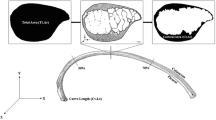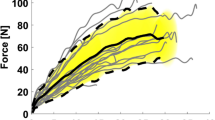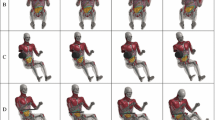Abstract
Finite element human body models (HBMs) are used to assess injury risk in a variety of impact scenarios. The ribs are a key structural component within the chest, so their accuracy within HBMs is vitally important for modeling human biomechanics. We assessed the geometric correspondence between the ribs defined within five widely used HBMs and measures drawn from population-wide studies of rib geometry, focusing on (1) rib global shape, (2) rib cross-sectional size and shape, and (3) rib cortical bone thickness. A parametric global shape model fitted to all HBM ribs was compared to expected rib parameters calculated for each HBM’s subject demographic using population reference data. The GHBMC M50 and THUMS M50 male HBMs showed 24% and 50% of their fitted rib shape parameters (6 parameters per each 12 ribs) falling outside 1SD from population expected values, respectively. For female models the GHBMC F05, THUMS F05, and VIVA F50 models had 21%, 26%, and 19% of their rib shape parameters falling outside 1SD, respectively. Cross-sectional areas and inertial moments obtained along the HBM ribs were compared to average ± 1SD corridors for male and female ribs drawn from reference population data. The GHBMC M50, THUMS M50, and VIVA F50 model ribs were all larger in overall cross-sectional area than their targeted average population values by 0.9SDs (average across the rib’s full length), 1.7SDs, and 1.3SDs, respectfully. When considering cortical bone cross-sectional area, the THUMS and VIVA models—which each define a constant bone thickness value across the entire rib—overestimated bone content on average by 1.1SDs and 1.2SDs, respectively. HBMs have traditionally performed poorly when predicting rib fracture onset or fracture site, and in all HBMs in this study the rib regions with the most extreme cortical bone thickness and cross-sectional area discrepancies (compared to average reference data) corresponded to regions toward the sternal end of the ribs where rib fractures most frequently occur. Results from this study highlight geometrical components of current HBM ribs that differ from the rib geometry that would be expected from within those models’ target demographics, and help researchers prioritize improvements to their biofidelity.










Similar content being viewed by others
References
Agnew AM, Murach MM, Dominguez VM, Sreedhar A, Misicka E, Harden A, Bolte JH, Stammen J, Moorhouse K (2018) Sources of variability in structural bending response of pediatric and adult human ribs in dynamic frontal impacts. In: 62nd stapp car crash conference, The Stapp Association. https://doi.org/10.4271/2018-22-0004
Choi HY, Kwak DS (2011) Morphologic characteristics of Korean elderly rib. J Autom Saf Energy 2:122–127
Davis ML, Koya B, Schap JM, Gayzik FS (2016) Development and full body validation of a 5th percentile female finite element model. Stapp Car Crash J 60:509–544
Forman J, Poplin GS, Shaw CG, McMurry TL, Schmidt K, Ash J, Sunnevang C (2019) Automobile injury trends in the contemporary fleet: belted occupants in frontal collisions. Traffic Inj Prev 20(6):607–612. https://doi.org/10.1080/15389588.2019.1630825
Fryar CD, Gu Q, Ogden CL (2012) Anthropometric reference data for children and adults: United states, 2007–2010. Vital Health Stat Ser 11(252):1–48
GHBMC (2019) Global human body models consortium (GHBMC) user manual, M50 detailed occupant version 5.0 for LS-DYNA
Holcombe SA, Wang SC, Grotberg JB (2016) Modeling female and male rib geometry with logarithmic spirals. J Biomech 49(13):2995–3003. https://doi.org/10.1016/j.jbiomech.2016.07.021
Holcombe SA, Wang SC, Grotberg JB (2017) The effect of age and demographics on rib shape. J Anat 231(2):229–247. https://doi.org/10.1111/joa.12632
Holcombe SA, Kang YS, Derstine BA, Wang SC, Agnew AM (2019a) Regional maps of rib cortical bone thickness and crosssectional geometry. J Anat 235(5):883–891. https://doi.org/10.1111/joa.13045
Holcombe SA, Kang YS, Wang SC, Agnew AM (2019b) The accuracy of local rib bone geometry measurement using full body ct images. In: Proceedings of the international research council on the biomechanics of injury conference, international research council on biomechanics of injury, vol IRC-19, p 64
Hu J, Reed MP (2012) Focusing on vulnerable populations in crashes: recent advances in finite element human models for injury biomechanics research. J Autom Saf Energy 3(4):295
Hwang E, Hu J, Reed MP (2019) Validating diverse human body models against side impact tests with post-mortem human subjects. J Biomech. https://doi.org/10.1016/j.jbiomech.2019.109444
Iraeus J, Lundin L, Storm S, Agnew A, Kang YS, Kemper A, Albert D, Holcombe S, Pipkorn B (2019) Detailed subject-specific FE rib modeling for fracture prediction. Traffic Inj Prev. https://doi.org/10.1080/15389588.2019.1665649
Iwamoto M, Kisanuki Y, Watanabe I, Furusu K, Miki K, Hasegawa J (2002) Development of a finite element model of the total human model for safety (THUMS) and application to injury reconstruction. In: Proceedings of the international research council on the biomechanics of injury conference, international research council on biomechanics of injury, vol 30, pp 12-p
Kemper AR, McNally C, Pullins CA, Freeman LJ, Duma SM, Rouhana SM (2007) The biomechanics of human ribs: material and structural properties from dynamic tension and bending tests. Stapp Car Crash J 51:235–273
Kimpara H, Lee JB, Yang KH, King AI, Iwamoto M, Watanabe I, Miki K (2005) Development of a three-dimensional finite element chest model for the 5th percentile female. Stapp Car Crash J 49:251–269
Lee EL, Craig M, Scarboro M (2015) Real-world rib fracture patterns in frontal crashes in different restraint conditions. Traffic Inj Prev 16(sup2):S115–S123. https://doi.org/10.1080/15389588.2015.1062888
Mohr M, Abrams E, Engel C, Long WB, Bottlang M (2007) Geometry of human ribs pertinent to orthopedic chest-wall reconstruction. J Biomech 40(6):1310–1317. https://doi.org/10.1016/j.jbiomech.2006.05.017
Murach MM, Kang YS, Goldman SD, Schafman MA, Schlecht SH, Moorhouse K, Bolte JH, Agnew AM (2017) Rib geometry explains variation in dynamic structural response: potential implications for frontal impact fracture risk. Ann Biomed Eng 45(9):2159–2173. https://doi.org/10.1007/s10439-017-1850-4
Östh J, Mendoza-Vazquez M, Linder A, Svensson MY, Brolin K (2017) The viva openhbm finite element 50th percentile female occupant model: whole body model development and kinematic validation. In: Proceedings of IRCOBI conference, Antwerp, pp 443–466
Perz R, Toczyski J, Subit D (2015) Variation in the human ribs geometrical properties and mechanical response based on x-ray computed tomography images resolution. J Mech Behav Biomed Mater 41:292–301. https://doi.org/10.1016/j.jmbbm.2014.07.036
Schoell SL, Weaver AA, Vavalle NA, Stitzel JD (2015) Age- and sex-specific thorax finite element model development and simulation. Traffic Inj Prev 16(sup1):S57–S65. https://doi.org/10.1080/15389588.2015.1005208
Schwartz D, Guleyupoglu B, Koya B, Stitzel JD, Gayzik FS (2015) Development of a computationally efficient full human body finite element model. Traffic Inj Prev 16(sup1):S49–S56. https://doi.org/10.1080/15389588.2015.1021418
Shigeta K, Kitagawa Y, Yasuki T (2009) Development of next generation human body fe model capable of organ injury prediction. In: Proceedings of international technical conference on the enhanced safety of vehicles, National Highway Traffic Safety Administration, vol 2009
Talbot BS, Gange CP, Chaturvedi A, Klionsky N, Hobbs SK, Chaturvedi A (2017) Traumatic rib injury: patterns, imaging pitfalls, complications, and treatment. RadioGraphics 37(2):628–651. https://doi.org/10.1148/rg.2017160100
Toyota Motor Corporation (2011a) Total human model for safety (THUMS) user’s manual, AF05 Pedestrian/Occupant Model. Version 4
Toyota Motor Corporation (2011b) Total human model for safety (THUMS) user’s manual, AM50. Version 4
Vavalle NA, Moreno DP, Rhyne AC, Stitzel JD, Gayzik FS (2012) Lateral impact validation of a geometrically accurate full body finite element model for blunt injury prediction. Ann Biomed Eng 41(3):497–512. https://doi.org/10.1007/s10439-012-0684-3
Vavalle N, Schoell S, Weaver A, Stitzel J, Gayzik F (2014) Application of radial basis function methods in the development of a 95th percentile male seated fea model. Stapp Car Crash J 58:361–384
Watanabe R, Miyazaki H, Kitagawa Y, Yasuki T (2011) Research of collision speed dependency of pedestrian head and chest injuries using human fe model (thums version 4). In: 22nd international technical conference on the enhanced safety of vehicles (ESV), WA, pp 11–0043
Witt CE, Bulger EM (2017) Comprehensive approach to the management of the patient with multiple rib fractures: a review and introduction of a bundled rib fracture management protocol. Trauma Surg Acute Care Open 2(1):e000064. https://doi.org/10.1136/tsaco-2016-000064
Zhang K, Cao L, Fanta A, Reed MP, Neal M, Wang JT, Lin CH, Hu J (2017) An automated method to morph finite element whole-body human models with a wide range of stature and body shape for both men and women. J Biomech 60:253–260. https://doi.org/10.1016/j.jbiomech.2017.06.015
Author information
Authors and Affiliations
Corresponding author
Ethics declarations
Conflict of interest
The authors declare that they have no conflict of interest.
Additional information
Publisher's Note
Springer Nature remains neutral with regard to jurisdictional claims in published maps and institutional affiliations.
Rights and permissions
About this article
Cite this article
Holcombe, S.A., Agnew, A.M., Derstine, B. et al. Comparing FE human body model rib geometry to population data. Biomech Model Mechanobiol 19, 2227–2239 (2020). https://doi.org/10.1007/s10237-020-01335-2
Received:
Accepted:
Published:
Issue Date:
DOI: https://doi.org/10.1007/s10237-020-01335-2




